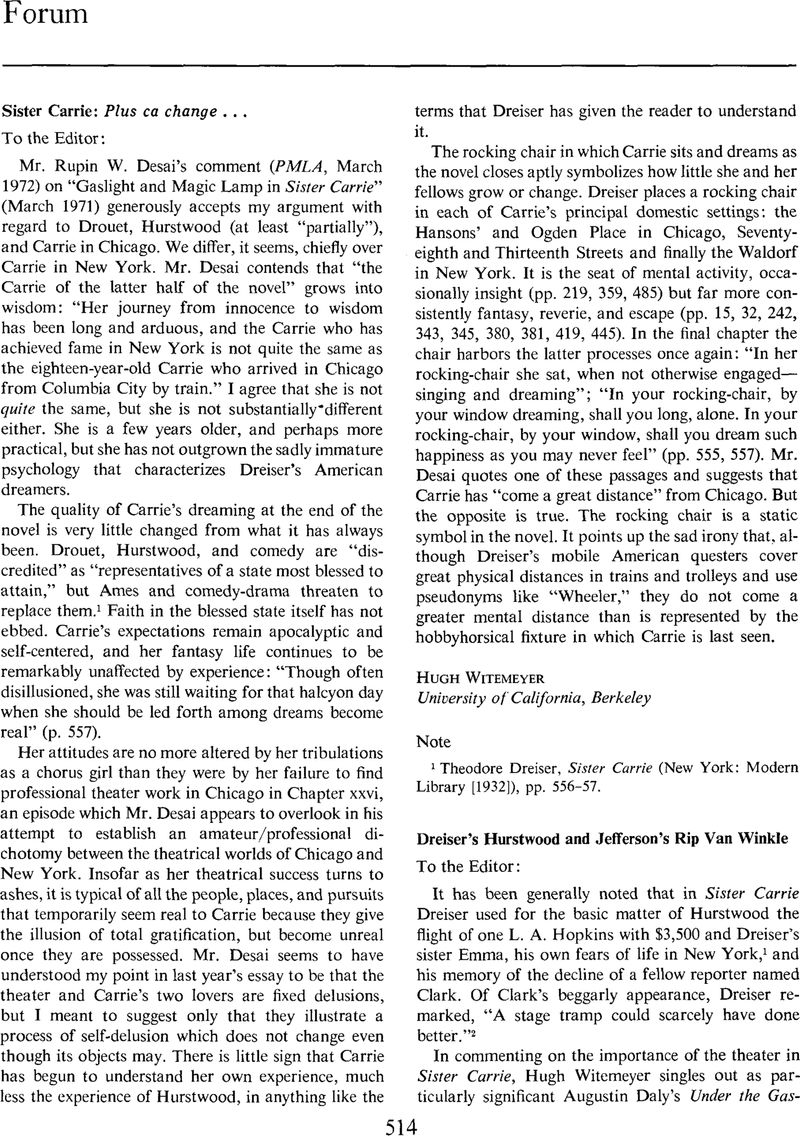No CrossRef data available.
Article contents
Dreiser's Hurstwood and Jefferson's Rip Van Winkle
Published online by Cambridge University Press: 01 December 2020
Abstract

- Type
- Forum
- Information
- Copyright
- Copyright © Modern Language Association of America, 1972
References
1 Dreiser himself, in watching “that large company of bums, loafers, tramps, idlers, the flotsam and jetsam” of City Hall Park, said, “I presume I looked at them and then considered myself and these great offices, and it was then that the idea of Hurstwood was born. A Book about Myself (New York: Liveright, 1922), pp. 463–64.
2 A Book about Myself p. 225.
3 “Gaslight and Magic Lamp in Sister Carrie” PMLA, 86 (March 1971), 238.
4 That Dreiser admired Jefferson as an actor is clear. He said of the American theater, “A few things had been done, in acting at least, by Booth, Barrett, Macready, Forrest, Jefferson, Modjeska, Fanny Davenport, Mary Anderson, to name but a few,” and “Richard Mansfield and Felix Morris stand out in my mind as excellent, and Sol Smith Russell and Joseph Jefferson as amusing comedians” (A Book about Myself, p. 176). Moreover, Jefferson came to be so associated with the role of Rip that he continued to act the part from 1865 until a year before his death in 1905 (see Arthur Hobson Quinn, A History of the American Drama from the Beginning to the Civil War, 2nd ed., 1923; rpt. New York: Appleton, 1951, p. 332).
5 Witemeyer, p. 237.
6 For an account of the evolvement of the play Rip Van Winkle, see Quinn's A History, pp. 325–32.
7 “Rip Van Winkle,” as played by Joseph Jefferson, Representative American Plays, 7th ed., ed. Arthur Hobson Quinn (New York: Appleton, 1953), p. 427. The Quinn edition of the play will be cited hereinafter with parenthetic page references in the text. Donald Pizer, ed., Sister Carrie (New York: Norton, 1970), p. 376, n. 2, observes that Dreiser's sister “Emma, whose full name was Emma Wilhelmina, was . . . often called Minnie, which suggests that Dreiser may have derived the name Carrie as a diminutive parallel to Minnie. Carrie's sister, it should also be recalled, is named Minnie Hanson.” The idea of a young girl named Meenie about to be thrown out into the world on her own may have struck an especially responsive chord with Dreiser.
8 Sister Carrie (New York: Modern Library [1932]), p. 531, cited hereinafter with parenthetic page references in the text.




